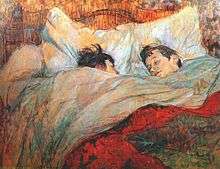Blanket

A blanket is a kind of bedding. It is, generally speaking, a large piece of woven cloth, intended to keep the user warm, traditionally while sleeping or lying down. A blanket traps the radiant heat from the user's body, and instead of dissipating into the air, it warms the user. It also protects against heat being lost by the processes of convection.
Usage
Blankets are distinguished from bed sheets because of their thickness and purpose. Blankets are thicker; even the thinnest blanket is thicker than the heaviest sheet. Blankets are generally used for warmth and comfort, while sheets are for hygiene, comfort and aesthetics. Blankets were traditionally made of wool because of wool's warmth, breathability and natural fire-retardant properties, while sheets were made of cotton or linen or silk, which are less irritating to the skin. Nowadays, synthetic fibers are frequently used for both.
Etymology
The term arose from the generalization of a specific fabric called Blanket fabric, a heavily napped woolen weave pioneered by Thomas Blanket (Blanquette), a Flemish weaver who lived in Bristol, England in the 14th century.[1][2] Earlier usage of the term is possible through its derivation from the French word for white, blanc.[3][4]
Types

Many types of blanket material, such as wool, are used because they are thicker and have more substantial fabric to them, but cotton can also be used for light blankets. Wool blankets are warmer and also relatively slow to burn compared to cotton. The most common types of blankets are woven acrylic, knitted polyester, mink, cotton, fleece and wool. Blankets also come with exotic crafting and exotic material such as crocheted afghan or a silk covering. The term blanket is often interchanged with comforter, quilt, and duvet, as they all have similar uses.
Uses
Blankets have been used by militaries for many centuries.[5] Most militaries have blankets as compulsory for sleeping quarters in preference to duvets. Militaries are some of the biggest single consumers of woolen blankets. Military blankets tend to be coarse grey with a high level of microns, usually over 20. Suppliers include J. E. Ashworth & Sons and Faribault Woolen Mills who made half of all blankets in America at one time.
Throw blankets are smaller blankets, often in decorative colors and patterns, that can be used for extra warmth and decoration on the outside of bed. Blankets are sometimes used as comfort objects by small children.[6]
Blankets may be spread on the ground for a picnic or where people want to sit in a grassy or muddy area without soiling their clothing. Temporary blankets have been designed for this purpose.
See also
References
- ↑ "Origin of Blanket". The New York Times. 24 March 1901.
- ↑ "Factors in the Development of the Cotswold Woollen Industry". 90: 349–362. JSTOR 1787694.
- ↑ "blanket". Podictionary. Retrieved 21 August 2012.
- ↑ "Online Etymology Dictionary: blanket". Etymonline.com. Retrieved 21 August 2012.
- ↑ Palmer, Alexandra (2004). Fashion: A Canadian Perspective. University of Toronto Press. ISBN 9780802085900.
- ↑ Gerritzen, Mieke; Lovink, Geert; Kampman, Minke (2011). I Read where I Am: Exploring New Information Cultures. Graphic Design Museum. ISBN 9789078088554.
External links
![]() Media related to Blankets at Wikimedia Commons
Media related to Blankets at Wikimedia Commons
![]() The dictionary definition of blanket at Wiktionary
The dictionary definition of blanket at Wiktionary